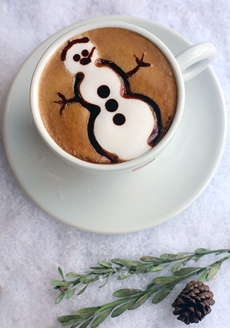FOOD FUN: Make A Snowman Latte Or Cappuccino

In a cup of hot coffee, he’s not so frosty (photo courtesy Illy). |
There may not be enough snow on the ground to build a snowman, but you can build one atop a cappuccino or latte, with this recipe from Illy. This easy-to-make snowman is fun for adults, and can be adapted to hot chocolate for kids. Depending on the age of the kids and your disposition to allow them coffee (the kids in our neighborhood seem to live on mocha lattes), a latte is only 1/6 coffee; a cappuccino, 1/3. See details below. Ingredients Per Drink |
|
|
See the step-by-step in this video. CAPPUCCINO & LATTE: THE DIFFERENCE Both drinks originated in Italian cafés, but are slightly different, based on the amount of milk. Latte art was enabled by the development of microfoam, a very velvety foam enabled by the steam wand of a cappuccino machine. The wand foams the milk in a stainless-steel pitcher; the pitcher pours the foam onto the top of the coffee. The combination of the natural crema atop the cup of espresso and velvety microfoam allows patterns to be made. (Note that other types of milk steamers/foamers do not create microfoam.) Latte art in the United States developed in the Seattle coffee culture of the 1980s and 1990s. By 1989 the heart pattern was a signature at David Schomer’s Espresso Vivace and the rosette pattern followed, based on a photograph Schomer saw of latte art in an Italian café. Here’s the history of espresso, which originated at the end of the 19th century.
|
||